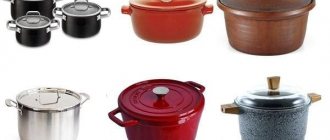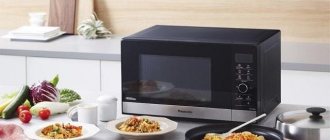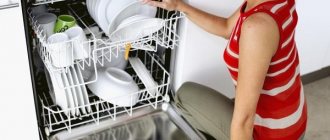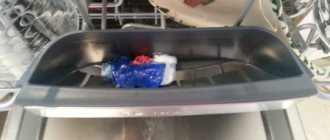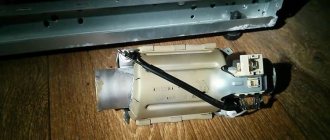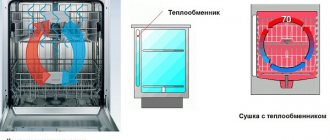Features of washing different materials in the dishwasher
It would be logical to start with what dishes can be washed in the dishwasher. Standard items include cutlery, glass and porcelain, heat-resistant plastic, and earthenware without gilding.
It is also worth considering which pans can be washed in the dishwasher:
- made of stainless steel with enameled, ceramic coating;
- aluminum frying pans with a protective layer;
- titanium types of products.
When asked whether a cast iron frying pan can be washed in the dishwasher, the answer is unequivocal - it is not. In other cases, to find out whether pans and other kitchen utensils can be washed in the dishwasher, it would be a good idea to refer to the instructions.
Glass
Thin glass products should be washed using a gentle cleaning mode and a temperature not exceeding +50 °C. If the dishes are strong and thick, any program will do. All items are placed at a distance of 5 cm from each other so that they do not touch, otherwise chips may form on the utensils.
Porcelain
Products made from this material can be easily cleaned using a machine. The only caveat is that if the dishes are decorated with gold or glaze, you need to choose a delicate program and water at room temperature.
Plastic
The equipment perfectly rinses heat-resistant containers, boards, and silicone molds. If the dishes are light, they must be securely fixed so that they do not move during washing. Wash plastic containers by hand unless the packaging indicates that the item is heat-resistant.
Ceramics
Ceramic dishes should be washed in the dishwasher; such products react well to hot water, cracks do not form on them, and the design and other design are preserved.
Having found out whether it is possible to wash a ceramic pan, it is worth remembering the need to clean large items in a special compartment, separately from small plates, cups, and other utensils.
Crystal
You can clean crystal glasses and other dishes made from this expensive material, but only at a temperature not exceeding 50 degrees. Under the influence of hot water, the products will begin to darken, and cracks will appear over time. When washing crystal, you need to add 1 tablespoon of vinegar to the machine to give the products shine.
Clay
Clay utensils are not suitable for processing under the influence of steam, vibration and high temperatures, as they will very soon become covered with cracks. In addition, the material absorbs detergents that are difficult to wash off from the surface. Modern clay products can be washed in a dishwasher on a delicate cycle only if they have a protective layer.
How to clean a non-stick frying pan in the dishwasher
Many people are afraid whether Tefal frying pans can be washed in the dishwasher. There is a lot of disagreement regarding kitchen aids and this type of utensil. Even though household appliances allow you to deal with stains extremely quickly and without hassle, many housewives, based on their own experience, recommend scrubbing off burnt marks exclusively by hand.
This is due to the fact that on some frying pans, after using a dishwasher, either white stains from scale appear, or the top layer deteriorates and, as a result, food begins to stick.
If your non-stick frying pan, according to the instructions on the package, is acceptable for washing in this way, you should follow some nuances.
- Use only soft and gentle products.
- Keep in mind that the Teflon coating should not be exposed to extremely high temperatures, so set the machine at 50 degrees.
- Do not wash Teflon in the dishwasher frequently - this will shorten its service life.
- And be sure to read the manufacturer's recommendations. Some pans are not at all designed to be cleaned in this unit.
Important : if the Teflon layer is damaged, it is better to discard such dishes - the food will constantly burn, and particles of the coating may enter the human body along with the food.
For which dishes is this cleaning method not suitable?
Next, it is advisable to find out which dishes cannot be washed in the dishwasher:
- Wooden kitchen utensils should only be cleaned by hand. Household appliances can wash out natural oils from them, the products will dry out and gradually begin to crack.
- It is also strictly forbidden to place the electric kettle in the dishwasher: the wires, LED, switch placed inside the product will immediately become unusable, and the metal contacts will become covered with oxides. It is better to carefully rinse the electric kettle under the tap, avoiding moisture getting inside the body.
- Acrylic or melamine dishes cannot withstand high temperatures, steam drying, or the influence of any detergents. After such washing, the products do not look very aesthetically pleasing; cracks form on them.
- The cast iron frying pan is washable only by hand. This cookware quickly rusts when exposed to water for a long time, and when exposed to chemicals, the non-stick layer can completely peel off. Temperature changes also negatively affect this material.
- Teflon-coated pans should not be placed in the dishwasher. Visually, you may not notice any damage, but the kitchen utensils will lose their factory characteristics.
- If the label does not indicate that plastic utensils can be washed in the dishwasher, it is better not to do so.
- Milk glass may turn yellow after just two loads under the influence of high temperatures and aggressive detergents.
- Products with a vacuum lid cannot be cleaned using a dishwasher: the utensil will be deformed and lose its seal.
- If you wash aluminum cookware in the dishwasher, a white coating will form on it, which can only be removed with abrasive substances. Due to oxidative processes, the material can also become irreversibly blackened, which is why aluminum cookware should not be washed in a machine.
- It is not recommended to place the pressure cooker lid into household appliances: small particles of dirt can clog the valves, and harsh detergents can damage silicone or rubber seals. The multicooker bowl will also not withstand the washing process; its inner coating will be damaged.
- Loading metal graters, strainers, and garlic presses is contraindicated. The machine cannot cope with washing out small stuck pieces of food, and the food itself runs the risk of becoming rusty. Aluminum utensils (for example, colanders) should also not be washed in the dishwasher.
- It is strictly forbidden to place exclusive hand-painted items in an automatic wash, otherwise the entire decor will be washed off or damaged.
- Cast iron cookware, grates and other utensils made of this material will soon become covered with rust after mechanical washing. You should not wash cast iron cookware in the dishwasher because it forms a protective barrier (a thin layer of fat that appears after the first cooking of the dish). This layer is destroyed in the machine, so you cannot wash a cast iron frying pan in the dishwasher.
- Silverware is also prohibited, since the chemical composition of dishwasher tablets causes dark stains on cutlery.
- Copper utensils will begin to oxidize and become covered with plaque, which can only be removed by polishing. Therefore, pans made of this alloy and pots cannot be washed in the dishwasher.
- Washing damaged glasses and plates is contraindicated, as there is a risk of damaging the equipment due to pieces of dishes breaking off during the cleaning process.
- By placing jars and containers with stickers into the device, the user risks clogging the drain hole with particles of paper and glue.
- Washing thermoses and thermal mugs in the dishwasher is prohibited. The inner part of the vessel under the influence of vibrations is easily damaged and loses its properties. Bacteria and food particles penetrate into the space between the body and the flask, and the material begins to rot, which is accompanied by an unpleasant odor.
- Decorative items - figurines, vases, etc. are also prohibited from being cleaned in this way, since there is no guarantee that they will be durable and will not break.
- It is not advisable to wash knives in the dishwasher. There is a risk of scratching internal parts and plastic mechanisms of the equipment. In addition, due to exposure to hot water and steam, the blades will become less durable.
Housewives often do not know whether baking sheets can be washed in the dishwasher. Meanwhile, many manufacturers include special attachments that allow you to conveniently place these bulky kitchen utensils inside the device (sometimes this will require removing the top tray intended for cutlery).
Enameled dishes are placed on the bottom shelf, the temperature is set to medium and a non-aggressive product with a mild composition without alkali is used.
Check the markings on the dishes
Cast iron frying pans
Teflon cookware
Thermoses and thermal mugs
Silver
Figurines and vases
Hand painted dishes
Wooden
Copper utensils
Sieve and garlic press
Damaged glasses and glasses
Aluminum
Melamine tableware
Additional use options
Of course, users are interested in what can be washed in the dishwasher, except for dishes. For example, brushes for a vacuum cleaner, clothes, washcloths, dustpans can be cleaned perfectly in it; you just need to first remove hair and pieces of dirt from their surface.
In one cycle you can clean rubber flip-flops, boots, beach sandals, sandals, and sneakers. Algorithm of actions:
- remove dirt from shoes;
- the insoles and liners are removed and washed by hand (the laces can be left on);
- load shoes, use a slightly alkaline detergent for washing;
- select the mode with the minimum temperature and start the equipment.
It is forbidden to wash shoes in hot water or treat them with steam - they will deteriorate.
Other uses:
- The machine can easily cope with cleaning Lego, as well as other toys and plastic products, without deforming them or washing out the color. The main recommendation is to use a delicate wash bag, this will prevent the drain from clogging.
- The dishwasher can be used to wash fruits and vegetables. You need to set the “rinse” mode and make sure that food does not fall into the drain.
- You can also load bowls and rubber animal toys. They must first be cleaned of wool.
- The hood grates are not afraid of hot water; you can even set the temperature to high.
- Machine mats can also be washed in the dishwasher. Dirt is first removed from them, and they are washed in any mode using powder.
- The shelves from the refrigerator are placed in the basket of household appliances, any detergent is poured in and the machine is started. The parts become clean, all unpleasant odors disappear.
In addition to eliminating dirt, all these products will be steam treated and disinfected accordingly.
Shoes
Lego
Fruits and vegetables
Rubber toys
Hood grille
Rules for using household appliances
First of all, it is important to choose the right cleaning product. For washing, you cannot use gels and powders for hand washing; they form foam, which will cause an emergency stop of the device. Special powders and tablets are sold for this technique. The last option is the most optimal, since the solid form of the product has cleaning, rinsing and disinfecting properties. For fragile products, preparations with enzymatic substances that can dissolve proteins and polysaccharides are used.
The next step is to distribute the dishes correctly, otherwise they will not be washed properly. First, the products are removed from food debris, and then placed tightly and compactly in the machine so that they do not interfere with the rotation of the mechanism, the opening of the dispensary and the free movement of water.
Tips for washing kitchen utensils in the dishwasher:
- Fragile glass products and glasses are placed in the upper section so that they do not touch the walls.
- More contaminated dishes are placed at the bottom, since there is a more powerful water pressure there. The dirtiest items are turned upside down.
- Cutlery is placed in a special tray. Forks and spoons are alternated, knives are placed with the blade facing up.
- In some models, sections can be moved to accommodate vases or baking trays.
Immediately after eating, you can load all dirty dishes into the appliance and close the lid. This way, the remaining food particles will not dry out while waiting for a new batch of plates to arrive.
The next step is to pour in powder or add tablets, and add rinse aid and salt if necessary. Next comes the selection of the appropriate mode; all possible options are described in the instructions. As a rule, they use a standard program - eco or economy. If your kitchen items are very dirty, it is better to choose an intensive wash that cleans well. However, such a program consumes a lot of electricity and water. The delicate option is designed for cleaning fragile items. If the housewife has loaded different dishes into the dishwasher, it is better to choose the gentle mode.
Which pans can be washed in the dishwasher?
Carefully studying the instructions will help you find out the possibility of cleaning dishes in a household appliance. The list of materials that can be processed in the dishwasher is quite large:
- stainless steel;
- enamel;
- ceramics;
- titanium.
Enameled and ceramic products must not be cleaned using products that contain chlorine, acid or alkali. It is contraindicated to treat a titanium kitchen item with boiling water or abrasive detergents.
Tin and copper products do not tolerate washing in the dishwasher and become stained and stained.
Housewives often ask whether popular products from Tefal can be cleaned in the dishwasher. Tefal's best-selling product has four types of protective layers. Regardless of its type, such pans can be processed in the dishwasher. Experts advise that after such cleaning, generously lubricate kitchen utensils with vegetable oil. However, it is still better to wash expensive products by hand.
It is dangerous to wash Teflon-coated dishes; the special layer will simply peel off due to exposure to aggressive detergents and high temperatures.
Additional Information! Products should be placed sideways or upside down in the dishwasher. This position will help to process the dishes from all sides.
Is it worth washing a cast iron frying pan?
Can a cast iron skillet be washed in the dishwasher? To begin with, it is worth remembering the features of this metal. Its surface can be called uneven. Because of this feature, cast iron products are calcined with fat to clog microscopic pores.
It is best to use sunflower oil.
The protective layer of a cast iron frying pan is washed off during processing. As a result, the product rusts and becomes unusable. If you then want to use such kitchen utensils, the risk of getting food stuck to the bottom of the pan increases instead of a tasty dish.
Products made of cast iron can be washed in PMM, but covered with an enamel or ceramic protective coating.
Cleaning an Aluminum Frying Pan
Aluminum products are popular among housewives because of their low cost. With proper care, they look beautiful, but in rare cases such utensils remain in their original form for a long time.
Washing aluminum pans in the dishwasher is contraindicated.
After the dishwasher, the metal noticeably darkens and loses its presentation. The reason for the deformation of aluminum lies in the peculiarities of its composition. These pans have a protective oxide layer. Strong water pressure combined with alkaline detergents washes away this film. As a result, the aluminum is destroyed and its surface is no longer shiny. The exception is a product that has a protective coating.
Even gentle operating modes of the device shorten the service life of such pans.
Attention! Gastroenterologists claim that as a result of such processing, aluminum becomes unsafe for health.
Which pans can and cannot be washed in PMM
Let's start with what should not be put in the dishwasher. These are frying pans made of cast iron , aluminum , and also with Teflon coating .
The surface of cast iron products is uneven, almost porous. Therefore, before each use, it is recommended to heat dishes with sunflower oil: it clogs the pores, forming a smooth protective film. When exposed to detergents or hard brushes, the protective layer is washed off. As a result, the surface begins to rust and food begins to stick.
A cast iron frying pan in the dishwasher is affected by washing gels (at best), or even powders with abrasive particles. A long stay in water is also not good for the material.
The same goes for Teflon products. This is a polymer coating that is easily washed off under mechanical stress. Therefore, it is recommended to stir even food in Teflon containers with a wooden spatula. If you put the device in the dishwasher, the coating will peel off.
Since Teflon has non-stick properties, washing it by hand is not difficult, just like cast iron products. But here you need to adhere to the rules:
- Do not use abrasive powders;
- metal brushes;
- gels that contain a lot of alkali.
How to save the situation if you have already taken the frying pan out of the dishwasher and noticed traces of rust:
- Wash away rusty deposits with warm water and a soft sponge.
- Dry with a dry towel.
- Rub the inside with oil.
- Sprinkle with table salt.
- Warm it up. As soon as a characteristic smell appears, turn off the heat and let the salt cool.
- Remove the salt and rub the inner and outer surfaces with sunflower oil. It will help restore the protective layer.
Teflon can be treated with warm water and a small amount of washing gel.
Aluminum frying pans have proven to be cheap and inefficient appliances. They heat up quickly, but should not be overheated, so food often sticks to the surface.
Why aluminum products should not be placed in the dishwasher:
- devices darken;
- this is unsafe for health - aluminum negatively affects memory, digestion, etc.
How does a dishwasher degrade aluminum? The surface of the pan is covered with a protective oxide film. Under the influence of strong pressure of water and alkaline agents, the film is washed off. As a result, the material reacts with water, darkens and collapses.
Some users claim that they have repeatedly washed aluminum appliances in PMM at 35 degrees. We warn you that the consequences may not be noticeable the first time.
Can a non-stick frying pan be washed in the dishwasher?
The protective layer of the product is easily damaged and almost impossible to restore. Which pans can be washed in the dishwasher without damaging the non-stick surface?
As for ceramic, enamel, titanium coating or stainless steel products, they can be safely washed in the dishwasher.
The stone layer is not afraid of any treatment. This product will last a long time, even if you clean it often in the dishwasher. Cast iron does not tolerate such treatment, but will not suffer from it if there is a ceramic or enamel protective layer.
The titanium surface does not deform when the pan is processed in the dishwasher.
Attention! Every housewife should know that it is impossible to load hot dishes into a household appliance. Using strong detergents will also damage the non-stick coating.
Cleaning a Teflon-coated pan
Dishes with such a protective layer cannot be processed in the dishwasher. We are talking about a polymer coating that will be damaged during mechanical impact. A similar warning also applies to the inadmissibility of stirring food while cooking with metal cutlery.
Teflon is a coating that peels off after cleaning in the dishwasher.
You can wash a frying pan made of this material manually, but subject to certain rules. The product will be damaged if it is cleaned with metal brushes and abrasive powders. Not every gel is suitable for washing delicate surfaces.
The Teflon coating will become unusable if a detergent with a high alkali content is used.
Washing a ceramic frying pan
Housewives should not be afraid of ruining such dishes; they do not become cracked when treated with hot water.
If the frying pan is decorated with a pattern, it will not be damaged when cleaned in the dishwasher.
Experienced housewives know that you cannot use a dishwasher when it comes to cauldrons and pots made of certain materials.
Alkalis can cause white spots that cannot be washed off.
- Porcelain. This type of ceramic is quite fragile. A porcelain salad bowl in the dishwasher can crack under strong water pressure.
It is necessary to wash kitchen utensils immediately after preparing food.
- Faience. It has a lot in common with porcelain. Practical earthenware products become cloudy after being put in the dishwasher.
Do not rub the surface with iron brushes or abrasive cleaning powders.
Should you wash cast iron in the dishwasher?
Many housewives have heavy cast iron frying pans; they can last for decades with proper care. But with the advent of dishwashing equipment, some have wondered whether such pans can be washed in the dishwasher? In fact, cast iron is a rather brittle steel that has special properties, which we will not describe. The main thing you need to know is that cast iron pans cannot be washed in the dishwasher.
The surface of a cast iron frying pan is uneven, which is why some people call this material porous. In fact, the structure of this metal is quite dense and non-porous; if this were not so, it would absorb water like a sponge. Of course, cast iron does not absorb water, but oil does. To be more precise, it gives the impression that it absorbs. The oil only fills invisible recesses and irregularities; when interacting with oxygen, it polymerizes, forming a surface film, thereby making the pan more even and smooth.
New cast iron pans have a lacquer coating that makes them shiny, and over time it wears off and washes off.
If this film is washed off with chemicals, the pan will become rough, and the food cooked on it will stick so hard that it cannot be scraped off. In addition, active rusting processes of the metal will begin with active contact with air, which contains nitrogen, oxygen, and carbon. In general, a film on the surface of a cast iron frying pan protects it from environmental influences.
How to wash cast iron cookware correctly?
If the frying pan cannot be washed in the dishwasher, then it must be done manually, but only correctly. Even hand washing can ruin cast iron. Many people mistakenly believe that this metal is “not capricious,” however, cast iron requires no less care than Teflon.
A cast iron frying pan must be washed with hot water. In this case, you cannot:
- use cleaning powders;
- detergents with a high alkaline content;
- metal brushes.
Important! When cooking in a cast iron skillet, be sure to add oil.
If the food is still burnt, then you can wash off the carbon deposits as follows. You need to pour water into a frying pan, add a handful of salt and baking soda, and then boil for 30 minutes. All the carbon deposits will go away. If the soot is not strong, then simply fill the pan with water and leave overnight. After this, you can wash it with a mild detergent.
After washing, always wipe cast iron items with a dry cloth and lightly rub with oil to restore the protective film. Moreover, you need to rub not only the inner, but also the outer surface.
You can save a cast-iron frying pan after a dishwasher, on which you saw the first signs of rust, by calcining it with salt, for this:
- Wash the product in warm water to remove any rust.
- Wipe the pan dry.
- Rub the oil on the inner surface.
- Add table salt.
- Heat until slightly fragrant.
- Let the salt cool.
- Add salt.
- Wipe with a cloth soaked in oil.
Which pans are machine washable?
So, cast iron and Teflon pans cannot be washed in the dishwasher. The question arises, which ones are possible? Generally speaking, those who are not afraid of high water temperatures and chemicals. These pans include:
- those covered with stone are very durable and easy to maintain;
- made of stainless steel;
- with durable enamel and ceramic coating;
- with titanium coating;
- aluminum frying pans with an expensive anti-darkening coating.
If the dishwasher manufacturer allows you to wash the products in a machine, then you, for your part, do not forget the rules of machine washing:
- add detergent according to the dosage, otherwise excess will end up in food;
- place the frying pan in the basket so that the working surface faces down;
- Expensive frying pans should not be washed frequently in the dishwasher; as a rule, food does not burn on them, and washing them by hand is not difficult.
That's all, we hope you now understand which pans can be washed in the dishwasher. It is better to wash cast iron cookware by hand, and you can purchase a separate set for the dishwasher. Good luck!
Is it dangerous to clean cauldrons and pots in the dishwasher?
A cauldron and saucepan will not cause damage to the dishwasher if they are placed in it correctly. The main condition is to use the bottom tray to clean bulky dishes.
You cannot stack cauldrons and pots. As a result, they will not be washed, and the likelihood of damage to household appliances will increase.
What dangers does washing pans and pots pose to household appliances?
If you use your dishwasher correctly, there is little risk of it breaking. Pots and pans with wooden or plastic handles should not be placed in it. The fasteners may also not be able to withstand the significant weight of the cast iron product.
Light stainless steel will not harm your household appliance.
Why can’t you wash pans in the dishwasher without following the advice given? An impractical person pays twice. It is better to wash the frying pan by hand than to buy a new product in the future.
In what cases can cast iron still be washed in the dishwasher?
In the modern world, manufacturers of cast iron products try to keep up with technological progress and develop utensils that can withstand washing in the dishwasher. Usually the metal is covered with enamel, less often with more technologically advanced protective layers.
Look at the bottom of the dish or the instructions: there should be an icon saying whether this item can be washed in the dishwasher.
Cast iron cookware can last a really long time if you don't use too strong detergents and don't put it in the dishwasher.
Savings issues
Savings are always relevant, especially in an era of rising tariffs for energy, water and other natural resources. There are two ways to save money when using dishwashers:
- Night wash. If you have a two-tariff meter installed, it is beneficial for you to run household appliances at night. The devices have delay timers that simplify the task. At night the machine will work at an economy rate, and in the morning you will receive clean dishes.
- Economical programs. Choose a model that has economy modes. They are chosen for lightly soiled dishes - energy is saved. True, they are unlikely to be useful for pots.
Removal recommendations
Depending on the type of contamination, caring for the cauldron involves the following actions: soaking, cleaning and boiling.
Rust
Cast iron is an alloy containing iron. Porous in its structure, when saturated with moisture, a cast iron cauldron rusts. If you do not remove rust from the walls of the cauldron in time, then over time the dishes will become unusable.
A clear sequence of actions will help you clean the cauldron at home from rust quickly and efficiently:
- Prepare the necessary material: steel wool and an abrasive agent (coarse salt and soda are ideal).
- Fill the cauldron with water, add a pack of soda and salt, and place on low heat.
- After boiling, the mixture is boiled for about half an hour, after which the cauldron is removed from the heat and allowed to cool.
- Continue cleaning the cauldron from rust with a metal brush.
Cauldron with rust
Soot and carbon deposits
Laundry soap and PVA glue will help to quickly clean the walls of the cauldron from soot and deposits:
- Fill the container with water and put it on the fire.
- Rub the soap.
- Pour soap shavings into boiling water and add PVA glue.
- Place a cauldron in a boiling solution and boil it for two hours.
- Cool the water and clean the cauldron with a regular household sponge.
During digestion, the room must be well ventilated.
Soot and soot
Laundry soap and PVA glue will help get rid of soot and deposits.
Fat
There are several ways to clean a cauldron from old fat:
- Grate a bar of laundry soap on a fine grater. Then pour water into the boiling container, boil it, add soap shavings and a jar of PVA office glue. A cauldron with old fat is placed in the resulting mixture and boiled for three hours.
- Pour 200 ml of vinegar into a dirty cauldron and add two tablespoons of salt. The resulting mixture is brought to a boil, after which two tablespoons of soda are immediately added. It is important to monitor the fire and not allow the resulting foam to escape from the cauldron. Boil the mixture for thirty minutes, after which the stubborn layer of fat can be easily removed with a soft sponge.
Vinegar and salt can be used to wash greasy dishes
What are the dangers of automatic cleaning?
Cast iron, like any material, has a number of unique properties that must be taken into account when caring:
- cast iron is a dense alloy with an imperfectly smooth surface, in the unevenness of which oil, as well as household chemicals, is well fixed;
- after calcination, cast iron is covered with a thin film that protects it from rust and prevents food from burning;
- unheated metal is very vulnerable to rust;
- Cast iron is very hard and is not afraid of iron brushes.
It is common to think that cast iron products are absolutely unpretentious, and they “don’t care about anything,” but this is a deceptive impression. First of all, it is very hard, but fragile, and a strong blow will not bend, but rather split the dishes. When regularly washed in PMM, cast iron becomes riddled with microcracks, which accelerate the date of destruction of the cookware.
Secondly, cast iron rusts quite easily if it is not covered with enamel or if the oil film is destroyed. And the latter corrodes quite easily. How it works: the dishwasher uses a strong alkali in the cleaning agent, and it is supplied with a stream of hot water. These factors soften and wash off the film. Then the dishes are “dried”, but remain in a damp chamber for half an hour, or even several hours. As a result, the cauldron or frying pan rusts.
We recommend: What and how can you quickly and efficiently wash a grater?
Thirdly, alkali very successfully clogs the pores of cast iron and then moves onto the food, and when heated it also poisons the air.
Advice from “Miss Clean” Rust on cast iron or any other utensils should be removed immediately. This can be done in the following way: rinse thoroughly with water and the hard side of a sponge or scrape off with a metal brush. Then you need to restore the protective layer: grease the work surface with oil and warm it up.
How to properly wash a cauldron
Knowing how to wash a cauldron after cooking will help you quickly return it to its original appearance.
After cooking the pilaf
A properly prepared cauldron does not require special cleaning. It is important to heat the pot with oil for the first time before cooking pilaf and wipe it thoroughly with a rag. A special, natural protective film is formed on the walls of the cookware, preventing food from burning.
Subsequently, the cauldron is washed as follows:
- Free the dishes from food debris.
- Fill the cauldron with water, boil and leave to cool.
- Wash the dishes with warm water and a soft sponge (you can use liquid detergents).
- They wipe the dishes dry, then rub a drop of oil along the walls of the cast-iron vessel and, with the lid open, put it into storage.
Before washing the cauldron, you need to remove all food residues from it.
In the field
The following tips will help you quickly wash a dirty cauldron while on a hike:
- Heat the dishes with sand. To do this, a dirty cauldron is filled to the brim with fine river sand and left overnight on the coals of a fire. In the morning, remove the dishes from the heat, let them cool a little, and pour out the sand.
- Heat the cauldron with salt. For this cleaning method, the dishes are filled with salt (two packs are enough), after which the dishes are heated over low heat. The signal that the cauldron can be removed from the heat will be the darkened salt and the fat that has disappeared from the walls of the dish.
After calcination, do not forget to wash the dishes with water or wipe them with a dry, clean cloth. This will help remove soot from burnt fat.
Calcination with sand
Calcination with salt
How to wash using traditional methods
The most effective condition for long service life of Teflon cookware is immediate washing. However, if you are faced with complex stains, we offer several ways to solve the problem at home without the use of special detergents. Here are some tips on how to clean a Teflon pan using safe methods.
- It is enough to simply clean the surface from carbon deposits using soda ash. To do this, you need to pour half a liter of liquid into the frying pan and place it on the burner (the amount of water is adjusted depending on the area of contamination). Once the contents have boiled, add at least three tablespoons of soda. You can find this product in household chemical stores. Boil the solution for about a quarter of an hour, then wait until it cools completely and wipe with a sponge.
- Regular laundry soap will help remove grease from any surface. To achieve the result, grate ½ piece, add water and simmer in a frying pan for about 30 minutes.
- In the fight against severe stains, the same soda ash will help, only in combination with glue. You can clean a frying pan with this solution after boiling water in it for 30-40 minutes with the addition of a tube of silicate glue and a third of a pack of powder. The mixture should be left in the bowl until it cools.
- You can also remove carbon deposits with carbonated drinks. The “useful” properties of Coca-Cola have been known for a long time, and it is it that helps remove burnt-on food residues. To do this, pour the soda into the frying pan, put it on the fire and boil. If necessary, you can cover it with a lid - the vapors released will clean it too.
Important : it is prohibited to wash the non-stick coating using metal brushes, scrapers, or abrasives. To turn food, use only a special silicone spatula.
Dishwasher Care
Servicing a dishwasher does not take much time; you just need to follow a few simple rules.
- Ventilate the chamber after work, leaving the door slightly open - this will prevent the appearance of unpleasant odors.
- For external cleaning, use high-quality products for polishing devices without an abrasive effect. In this aspect, there is a difference between how to use a built-in dishwasher and a free-standing one. Built-in appliances are faced with panels in the same style as the furniture. The rules for caring for them should be obtained from the manufacturer of the kitchen set.
- The rubber seals become clogged with food debris that must be removed regularly with a soft sponge.
Follow these instructions, and the operation of the device will be as productive as possible. The machine will work for a long time, and the quality of washing will remain impeccable throughout its service life.
